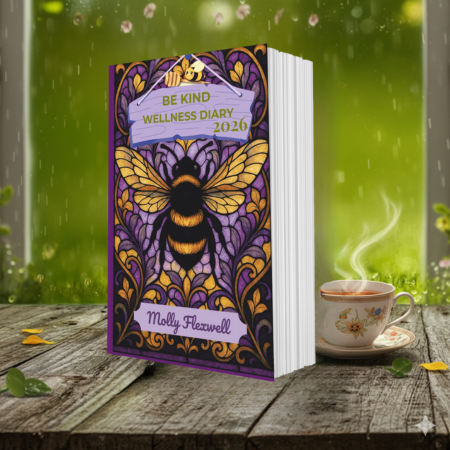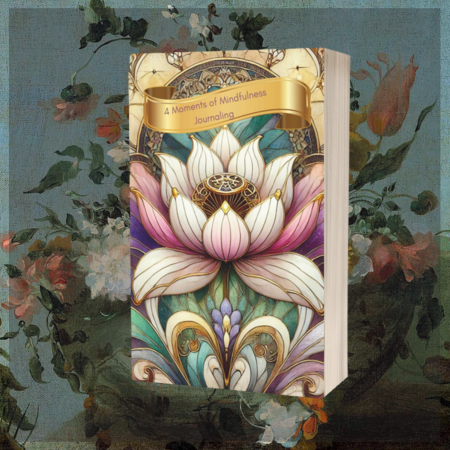“Molly Flexwell helps exhausted caregivers reclaim their energy, self-worth, and joy through practical tools and kindness-led living”
How do I start a gratitude journal for if a beginner gratitude journal? Let see if we can work this one out ! Have you have ever felt that your days blur together or that worry steals the brightness from ordinary moments, a gratitude journal is a small and gentle practice that can change the weather inside your mind. It is not complicated or difficult. It is a daily gratitude practice that helps you notice what is already here and let it matter. Many readers begin because they are curious about mindfulness and self care. They stay because gratitude journaling makes life feel more liveable and more beautiful, one line at a time. Research links regular gratitude to better wellbeing, stronger relationships, and greater happiness, which is a very good return on a few minutes with a pen. ggsc.berkeley.edu
What is a Gratitude Journaling:

A gratitude journal is simply a place where you record the things you appreciate. You might write three simple sentences about your morning tea, a kind text from a friend, or the way the late light found the kitchen bench. You can keep it in a notebook beside your bed or use a digital notes app if that suits your routine. The goal is not perfect prose. The goal is attention. This beginners guide is designed to help you start a sustainable habit that supports mental health, calms stress, and builds a more optimistic mindset through consistent gratitude prompts and reflective practice. Clinicians and researchers note that even brief, regular entries can support mood and reduce symptoms of depression while nurturing social bonds. PositivePsychology.com
Why Gratitude Journaling Works
Gratitude journaling directs your attention toward what is safe and good and meaningful. Over time that focus can shift your baseline outlook. Studies show that people who consciously count their blessings report fewer physical symptoms, higher optimism, and better life satisfaction than those who list hassles or neutral events. That pattern has been demonstrated both in general populations and in people living with health challenges. Greater Good+1
The Sleep Connection
One of the most encouraging findings for beginners is the sleep benefit. When you make space for appreciative thoughts before bed, your mind is less likely to spiral into what if loops. Multiple studies link gratitude to better sleep quality, shorter time to fall asleep, and feeling more refreshed in the morning. For many readers, an evening reflection becomes a calming anchor at the end of the day. Greater Good+1
The 4 Moments Method From Molly Flexwell

In The Four Moments of Mindfulness Journaling, Molly Flexwell invites you to weave appreciation into the natural shape of a day. Morning wake. Midday pause. Evening reflection. Lights out. These four touchpoints are a friendly framework that works beautifully for caregivers and busy professionals who need structure without pressure. You can use all four moments or begin with one. Think of them as small doors back to yourself.
How the Four Moments Look in Practice
Morning Wake
Write one line before your phone steals your focus. Name something you are glad to meet today. It could be a fresh start, sunlight across the duvet, or the sound of a child laughing in the next room. Use keywords your future self will love to search such as morning gratitude journal and daily gratitude practice.
Midday Pause
At lunch or between tasks, jot a quick note about a small win. Perhaps a warm cup of tea, a problem solved, or a five minute stretch that softened your shoulders. This is where your mindfulness habit grows. These entries also serve as prompts for later reflection.
Evening Reflection
After dinner, add two sentences about a connection or kindness you noticed. Relationships are a core driver of happiness and a gratitude journal strengthens that lens. If you are a caregiver, noticing one moment of genuine connection can shift the tone of a whole day.
Lights Out
Just before sleep, write a gentle line that releases the day. Something like I am thankful for the quiet in this room and the way my breath steadies me. This final moment supports sleep quality and completes a simple self care routine you can maintain. drjoannechapman.com+1
Step by Step for Absolute Beginners
Step One – Choose Your Tool
Pick a notebook/ Diary/ Journal you enjoy holding or a plain notes app. Avoid the trap of waiting for the perfect Gratitude Journal. The best gratitude journal is the one you will actually use. Popular guided journals can help if you like prompts and structure, but any blank page works. Calm Blog
Step Two – Set a Tiny Target
Begin with one line a day. If you feel like writing more, wonderful. If not, close the journal with a little promise to return tomorrow. Consistency matters more than volume and a small daily target keeps resistance low.
Step Three – Anchor It to a Routine
Place your journal where your habit will happen. On your pillow for the evening reflection. Beside the kettle for the morning gratitude journal entry. The cue helps you remember without effort.
Step Four – Use Simple Gratitude Prompts
Try these to start. Someone who made my day easier. A sensation in my body that feels good right now. One thing I can see that I would miss if it disappeared. One challenge that taught me something useful. A moment I want to remember from today. If you prefer a list approach, write three things you are grateful for and one reason each matters.
Step Five – Close With a Kind Sentence to Future You
End entries with a line that points you forward. Tomorrow I will look for a small moment of kindness at work. This practice turns your journal into a bridge between days and strengthens motivation.
Evidence Based Benefits You Can Expect
Improved mood and more optimistic outlook. Lower stress and depressive symptoms. Better sleep quality and a calmer mind at bedtime. Stronger relationships through appreciation and prosocial thinking. These outcomes appear consistently across many studies of gratitude practices including daily journaling. ggsc.berkeley.edu+2Greater Good+2
A gentle script for your first week
Day One
Write a single sentence about a small pleasure you might overlook. I am grateful for the way toast smells when it pops up and fills the kitchen with warmth.
Day Two
Write about a person. Thank them on the page. If you feel brave, send them a message. Acts of appreciation strengthen bonds and boost your mood. TIME
Day Three
List three good things that happened today and add one reason each mattered. This deepens the experience and teaches your brain to notice detail.
Day Four
Use the senses. One thing you can see, one you can hear, one you can touch. Noticing sensory detail grounds you in the present and reduces stress.
Day Five
Write a sentence about your body doing something right. My legs carried me through a long day. Gratitude for the body fosters respect and kinder self talk.
Day Six
Write about a challenge and how you coped. Gratitude is not pretending everything is perfect. It is acknowledging your capacity to meet life as it is. Studies in positive psychology suggest that this mindset supports resilience. ggsc.berkeley.edu
Day Seven
Return to the four moments. Morning wake line. Midday pause note. Evening reflection. Lights out sentence. Notice how the practice fits more easily than it did on day one.
Common Roadblocks and How To Move Through Them

I Repeat Myself
Repetition is fine. If you feel stuck, change the question. Ask What surprised me today. Who helped me today. What did I learn.
I Forget to Write
Pair your journal with something you already do. Put it on your pillow so you have to move it to sleep. Place a pen inside your mug so your morning routine triggers the habit.
I Feel Fake Writing Cheerful Things When Life is Hard
Gratitude is not a gloss. You are allowed to include the true state of things. One useful structure is This was difficult today, and I am grateful that. That tiny and reconnects you with agency.
I Want Proof This is Working
Look back after three weeks. Many beginners report clearer mood, steadier sleep, and a kinder voice toward themselves. Healthcare sources point to measurable benefits across sleep quality and emotional health, which supports what you will feel subjectively. Harvard Health
Gratitude for Caregivers and Helpers
If you are caring for others, this practice is made for you. A caregiver often runs on empty and forgets to feel the good moments as they pass. Gratitude journaling helps you notice micro wins and anchors your attention in the present. It takes minutes and can ride along with tasks you already do. A line while the kettle boils. A note on your phone in the car before you walk inside. Over time it becomes a soft rhythm in your day and a way to protect your compassion from burnout. Readers who blend gratitude journaling with brief mindfulness find the combination especially calming and sustainable.Calm Blog
“Begin small and kindly, thank the cup of tea, the sliver of light, the steady breath, and let your heart learn to notice more” Molly
The Wellness Hive For Caregivers Collections
The Wellness Hive for Caregivers Collections/ Shop is a gentle corner of the internet devoted to the people who hold everything together. It is a shop designed for caregivers, nurses, shift workers, and supporters who are giving so much of themselves and want simple ways to refill their own cup. Inside, you will find kind, practical wellness tools that make everyday care a little lighter and a lot more loving.
What we offer
- Caregiver self-care tools: gratitude journals, affirmation cards, reflection prompts, and gentle grounding practices that fit into real life.
- Planners and diaries: week-to-view wellness diaries, daily routines, and printable planners that help you protect your time and energy.
- Mindful downloads: instant digital guides for breathing, grounding, and journalling, plus caregiver checklists and calm-in-a-minute rituals.
- Beautiful gifts: Art Nouveau and stained-glass inspired designs in soft, uplifting colours that bring a little joy to a long day.
- Resources for burnout prevention: practical strategies for boundaries, rest, and recovery, created with caregivers in mind.
Who it is for
- Family caregivers who are balancing appointments, emotions, and the unexpected.
- Nurses and healthcare workers seeking quick, repeatable resets between shifts.
- Mothers and parents who want five calming minutes that actually work.
- Anyone feeling overwhelmed and ready for small steps back to clarity and calm.
How our products help
- Reduce decision fatigue with ready-to-use checklists, routines, and prompts.
- Support mental health with simple grounding exercises and gratitude journalling.
- Build resilience through tiny, consistent practices that fit into busy days.
- Make self-care visible with beautiful tools that invite you to pause and breathe.
What makes us different
- Created by a caregiver for caregivers, with lived insight and compassionate design.
- Evidence-informed practices translated into everyday language and easy routines.
- A kindness-led philosophy that treats rest and support as necessary, not optional.
- Art that soothes: bees, florals, and stained-glass motifs that feel hopeful and calm.
How it works
- Digital items arrive instantly so you can start today.
- Physical items are printed with care and packed as if they were for a friend.
- Clear, human support if you ever need help choosing or using a product.
Our promise
Molly Flexwell helps exhausted caregivers reclaim their energy, self-worth, and joy through practical tools and kindness-led living. We will never add to your overwhelm. Every product focuses on clarity, usefulness, and kindness, so you can move through your day with more steadiness and a little more light.
